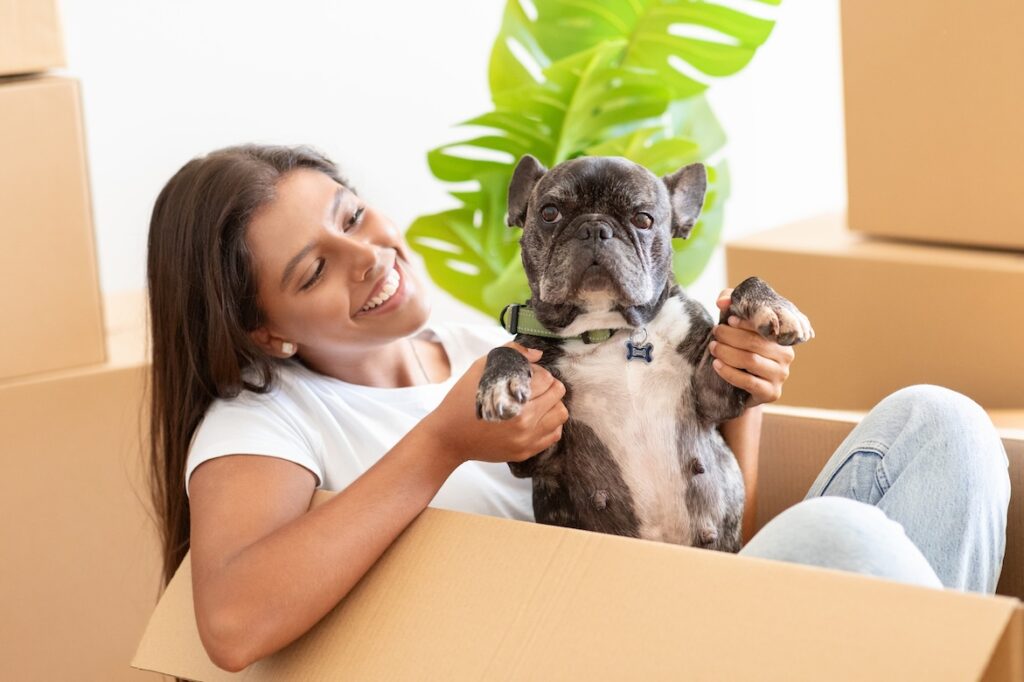
Moving with Pets: A Complete Guide to Keeping Your Pets Safe and Happy

Moving can be a stressful experience for everyone involved, including your furry family members. Pets are sensitive to changes in their environment, and the chaos of a move can make them feel anxious and unsettled. With a little planning and preparation, however, you can ensure that your pets stay safe, happy, and comfortable throughout the moving process. In this guide, we’ll provide tips for moving with pets, from packing up your old home to settling into your new one.
1. Prepare a Pet Moving Kit
Before moving day, create a pet-specific moving kit to keep all the essentials in one place. This kit should include:
- Food and water (enough for the journey and a few days after the move)
- Bowls for feeding and drinking
- Leash, harness, and collar with updated ID tags
- Favorite toys or blankets for comfort
- Litter box and litter (for cats)
- Medications and pet medical records
- Waste bags (for dogs) and cleaning supplies
Having these items readily accessible will help keep your pet comfortable during the transition and reduce the need to unpack immediately upon arrival.
2. Get Your Pet Used to Moving Supplies
If your pet isn’t used to carriers, crates, or car rides, start acclimating them weeks before the move. Place the carrier or crate in a familiar area and encourage your pet to explore it on their own terms. Reward them with treats and positive reinforcement whenever they show interest. This will help reduce stress when it’s time to travel.
3. Keep Your Pet’s Routine Consistent
Pets thrive on routine, so try to maintain their regular schedule as much as possible leading up to and during the move. Keep feeding, walking, and playtimes consistent to provide a sense of normalcy amid the changes. Familiar routines will help minimize anxiety for your pet.
4. Secure a Safe Space on Moving Day
Moving day can be chaotic, with doors opening and closing, strangers coming in and out, and lots of noise. To keep your pet safe and out of harm’s way, set up a designated room or area where they can stay secure and comfortable. Include their bed, toys, food, and water to create a calming environment. You might even consider boarding them with a trusted friend, family member, or pet daycare for the day.
5. Transport Pets Safely
Whether you’re moving across town or across the country, transporting your pet safely is crucial. Here are a few tips:
- For Dogs and Cats: Use a well-ventilated carrier or crate. Secure the carrier in your vehicle to prevent it from sliding or tipping over. Never let your pet roam freely in a moving vehicle.
- For Small Pets (e.g., rabbits, hamsters): Use a smaller travel cage with proper ventilation and enough room for your pet to move around.
- For Fish: Transport fish in clean, plastic containers with a secure lid. Avoid feeding your fish for 24 hours before the move to reduce waste in the water.
- For Birds: Cover the cage with a lightweight cloth to keep your bird calm, and secure it in the vehicle.
Make sure to take breaks on longer trips to check on your pets, offer them water, and allow bathroom breaks if needed.
6. Pet-Proof Your New Home
Before letting your pet explore their new environment, do a thorough check to ensure it’s safe. Look for any potential hazards such as exposed wires, toxic plants, or small spaces where they could get trapped. Set up a designated area for your pet with their bed, toys, and food bowls to help them feel more at ease.
- For Cats: Keep your cat in one room at first, then slowly introduce them to the rest of the house.
- For Dogs: Walk your dog around the new neighborhood and house on a leash to familiarize them with the new surroundings.
7. Update Your Pet’s Information
Don’t forget to update your pet’s information after the move. Make sure their ID tags have your new address and contact details. If your pet is microchipped, update the chip registration with your new information to ensure you can be reached if your pet gets lost.
8. Keep an Eye on Your Pet’s Behavior
Moving can cause stress for pets, which may manifest in changes in behavior. Keep an eye out for signs of anxiety, such as excessive barking, hiding, loss of appetite, or destructive behaviors. Give your pet plenty of time to adjust, and provide extra attention and reassurance as they settle into the new home.
If your pet continues to show signs of stress, consider consulting a veterinarian for advice on how to help them cope.
9. Create a Sense of Familiarity
To help your pet adjust, surround them with familiar items like their favorite toys, blankets, and bedding. These items carry their scent and provide a sense of security. Setting up their space similarly to your old home will also help create familiarity.
10. Gradually Introduce New Spaces
Instead of allowing your pet to roam the entire new home at once, introduce them to new rooms gradually. Start with one space, such as the living room or a designated pet area, and slowly allow them to explore the rest of the home at their own pace.
Moving with pets doesn’t have to be overwhelming. With the right planning, preparation, and patience, you can help your furry friends transition smoothly to their new home. By following these tips, you’ll ensure your pets remain safe, happy, and comfortable throughout the entire moving process.
BLOG
Related Articles


Corporate Relocating Made Simple: Streamlining Your Office Move

